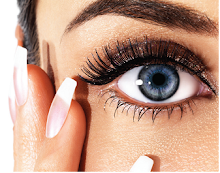Sclera forms the posterior five-sixth opaque part of the external fibrous tunic of the eyeball. Its whole outer surface is covered by Tenon's capsule. In the anterior part it is also covered by bulbar conjunctiva. Its inner surface lies in contact with choroid with a potential suprachoroidal space in between. In its anterior most part near the limbus there is a furrow which encloses the canal of Schlemm.
Thickness of sclera varies considerably in different individuals and with the age of the person. It is generally thinner in children than the adults and in females than the males. Sclera is thickest posteriorly (1mm) and gradually becomes thin when traced anteriorly. It is thinnest at the insertion of extraocular muscles (0.3 mm). Lamina cribrosa is a sieve-like sclera from which fibres of optic nerve pass.
Apertures. Sclera is pierced by three sets of apertures
(Fig. 1).
1. Posterior apertures are situated around the optic nerve and transmit long and short ciliary nerves and vessels.
2. Middle apertures (four in number) are situated slightly posterior to the equator; through these pass the four vortex veins (vena verticosae).
3. Anterior apertures are situated 3 to 4 mm away from the limbus. Anterior ciliary vessels pass through these apertures.
| Fig. 1. Apertures in the sclera. (posterior view) for: SCN, short ciliary nerve; SPCA, short posterior ciliary artery; LPCA, long posterior ciliary artery; VC, vena verticosa |
Microscopic structure. Histologically, sclera consists
of following three layers:
1. Episcleral tissue. It is a thin, dense vascularised layer of connective tissue which covers the sclera proper. Fine fibroblasts, macrophages and lymphocytes are also present in this layer.
2. Sclera proper. It is an avascular structure which consists of dense bundles of collagen fibres. The bands of collagen tissue cross each other in all directions.
3. Lamina fusca. It is the innermost part of sclera which blends with suprachoroidal and supraciliary laminae of the uveal tract. It is brownish in colour owing to the presence of pigmented cells.
Nerve supply. Sclera is supplied by branches from the long ciliary nerves which pierce it 2-4 mm from the limbus to form a plexus.




No comments :
Post a Comment
Waiting for your comments